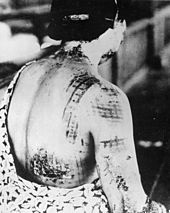 Pretty Scary Pretty Scary
Donald Trump has sent a tweet stating:
"The United States must greatly strengthen and expand its
nuclear capability until such time as the world comes to its
senses regarding nukes."
Picture - The mushroom
cloud of the atomic bombing of the Japanese city of Nagasaki
on August 9, 1945 rose some 11 miles (18 km) above the
bomb's hypocenter.
OMG....can you believe this? Is it me? Am I too old school?
Seems to me that tweeting should be relegated to high school
students, making last minute plan changes with friends, or
to those who simply have a lot of free time on their hands.
The fact that the president of the United States of America
is sending these "thoughts" without any regard to possible
consequences is scary to say the least. A tweet, such as the
one he sent, could easily throw the world into an arms race.
Maybe this is simply political posturing on his part, but it
still does not diminish the impact his words have on the
governments around the world. |
|
|
 High Cost High Cost
Nuclear weapons and materials degrade over time, and as
such, need to be constantly maintained, with costs totaling
in the billions of dollars annually. Not to mention the
costs to develop new bombs and the missiles, and other
means, needed to carry these weapons of mass destruction to
their final destination on some unsuspecting country.
Picture - Burns
visible on a woman in Hiroshima from the blast.
The
money for all of this will come from taxpayers like you, who
will soon see major spending cuts in education and health
services once "The Donald" takes office in January. Is this
where you want to see your money going? TO BUILD MORE BOMBS. |
|
 Global Impact Global Impact
Really sad to think this is the only solution world leaders
can find.
Picture - A photograph
of Sumiteru Taniguchi's back injuries taken in January 1946.
Instead of advancing humanity in a peaceful and
cooperative direction, people like Donald Trump seek to
exacerbate an already hostile world motivated by power and
greed. Hey Donald, why not try REDUCING the number of
nuclear bombs and get other countries to follow suit. There
are much better places where all of that money could be
spent. |
|
 Solutions Solutions
What can be done about this problem threatening all of
humanity?
Picture - Atomic bomb
mushroom clouds over Hiroshima (left) and Nagasaki (right).
There are several groups in the United States and
worldwide who support the reduction, not only of nuclear
weapons, but the use of nuclear power as an energy resource.
A few of these are listed here, and if you really want to make
some changes, then contact them, and see what they
recommend. |
-
Global Zero - A world without nuclear weapons
- Global Zero is a term in the literature of arms
control that refers to the worldwide elimination of a
weapons system, especially nuclear weapons or a
particular class of nuclear weapons.
-
The Atom Project - Abolish Testing Our Mission
- The ATOM Project is an
international campaign by the Nazarbayev Center of
Kazakhstan. The primary goal of the campaign is to
build international support for the abolishment of
nuclear testing. ATOM stands for "Abolish Testing. Our
Mission." The goal is to achieve in force the
Comprehensive Nuclear Test Ban Treaty through online
petitions and other methods.
-
ican - international campaign to abolish nuclear weapons
- The International Campaign to Abolish Nuclear Weapons is a
coalition of non-governmental organizations in around
100 countries advocating the negotiation of a
nuclear-weapon-ban treaty. The campaign has worked to
reframe public and diplomatic debates on nuclear weapons
to place the focus on their humanitarian and
environmental impacts, rather than abstract notions of
deterrence and strategic stability.
-
UNODA - United Nations Office for Disarmament Affairs
- The UN Office for Disarmament Affairs (UNODA) is an Office of
the United Nations Secretariat established in January
1998 as the Department for Disarmament Affairs, part of
the then United Nations Secretary-General Kofi Annan's
plan to reform the UN as presented in his report to the
General Assembly in July 1997. Its goal is to promote
nuclear disarmament and non-proliferation and the
strengthening of the disarmament regimes in respect to
other weapons of mass destruction, chemical and
biological weapons. It also promotes disarmament efforts
in the area of conventional weapons, especially
landmines and small arms, which are often the weapons of
choice in contemporary conflicts.
-
Anti-nuclear organizations
- A comprehensive list of groups pushing for the
abolition of weapons of mass destruction.
|
|
Did You Know? |
- The United States alone has enough in its
nuclear arsenal to destroy the world at least five times
over, and this is a conservative estimate, with some
claiming the figure could be closer to 50 times over? And
this is only the U.S.
- In Hiroshima on August 6, 1945, a
tremendous firestorm developed within 20 minutes after
detonation and destroyed many more buildings and homes,
built out of predominantly 'flimsy' wooden materials. A
firestorm has gale-force winds blowing in towards the
center of the fire from all points of the compass.
- There are two types of eye injuries
from the thermal radiation of a weapon:
- Flash blindness is caused by the
initial brilliant flash of light produced by the nuclear
detonation. More light energy is received on the retina
than can be tolerated, but less than is required for
irreversible injury. The retina is particularly
susceptible to visible and short wavelength infrared
light, since this part of the electromagnetic spectrum
is focused by the lens on the retina. The result is
bleaching of the visual pigments and temporary blindness
for up to 40 minutes.
- A retinal burn resulting in
permanent damage from scarring is also caused by the
concentration of direct thermal energy on the retina by
the lens. It will occur only when the fireball is
actually in the individual's field of vision and would
be a relatively uncommon injury. Retinal burns may be
sustained at considerable distances from the explosion.
The height of burst, and apparent size of the fireball,
a function of yield and range will determine the degree
and extent of retinal scarring. A scar in the central
visual field would be more debilitating. Generally, a
limited visual field defect, which will be barely
noticeable, is all that is likely to occur.
- The physical-damage mechanisms of a
nuclear weapon (blast and thermal radiation) are
identical to those of conventional explosives, but the
energy produced by a nuclear explosive is millions of
times more powerful per gram and the temperatures
reached are briefly in the tens of millions of degrees.
- Most of the material damage caused
by a nuclear air burst is caused by a combination of the
high static overpressures and the blast winds. The long
compression of the blast wave weakens structures, which
are then torn apart by the blast winds. The compression,
vacuum and drag phases together may last several seconds
or longer, and exert forces many times greater than the
strongest hurricane. Acting on the human body, the shock
waves cause pressure waves through the tissues. These
waves mostly damage junctions between tissues of
different densities (bone and muscle) or the interface
between tissue and air. Lungs and the abdominal cavity,
which contain air, are particularly injured. The damage
causes severe hemorrhaging or air embolisms, either of
which can be rapidly fatal. The overpressure estimated
to damage lungs is about 70 kPa. Some eardrums would
probably rupture around 22 kPa (0.2 atm) and half would
rupture between 90 and 130 kPa (0.9 to 1.2 atm).
- After the nuclear bombs were dropped
on Japan, an unknown person sitting outside, fully
exposed, on the steps of the Sumitomo Bank, next door to
the Bank of Japan, received lethal third degree burns
and was then likely killed by the blast, in that order,
within two seconds.
|
|
Additional Reading |
|
|
|
|